
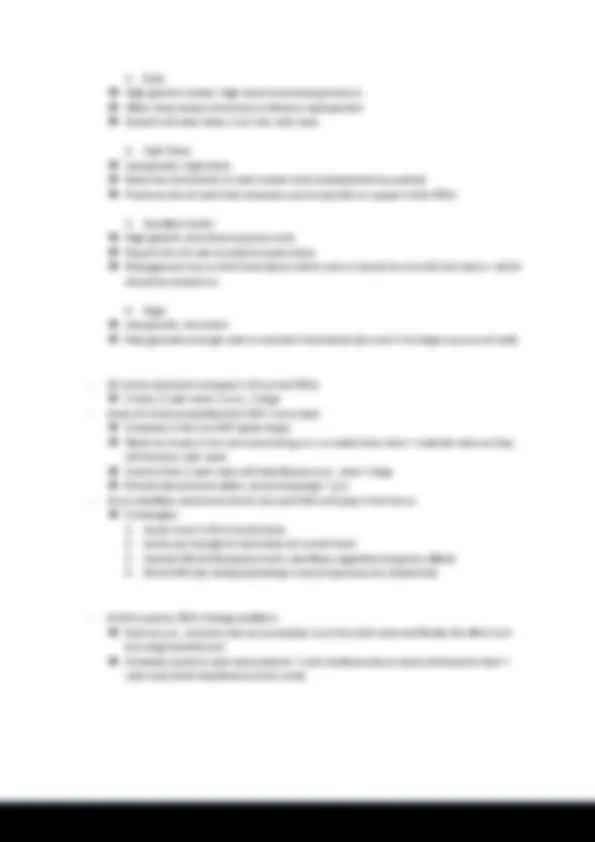
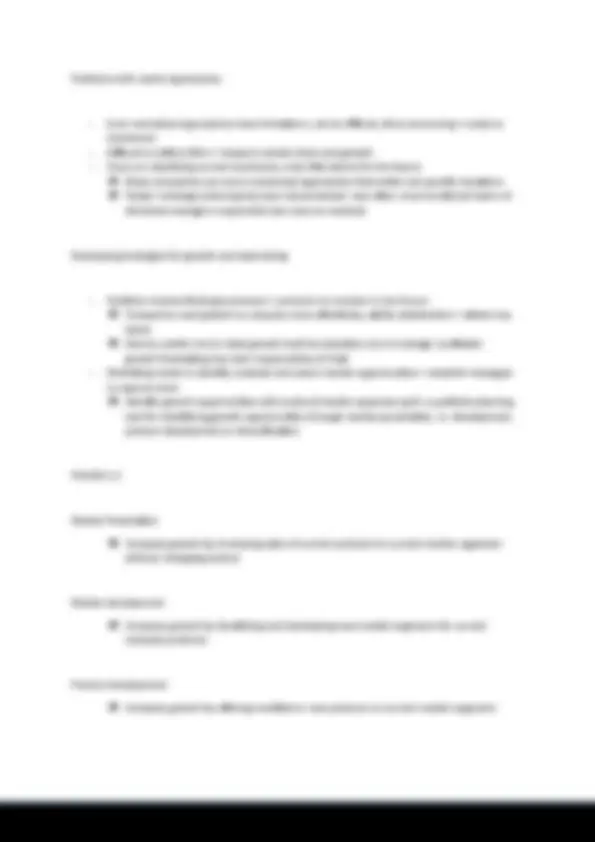
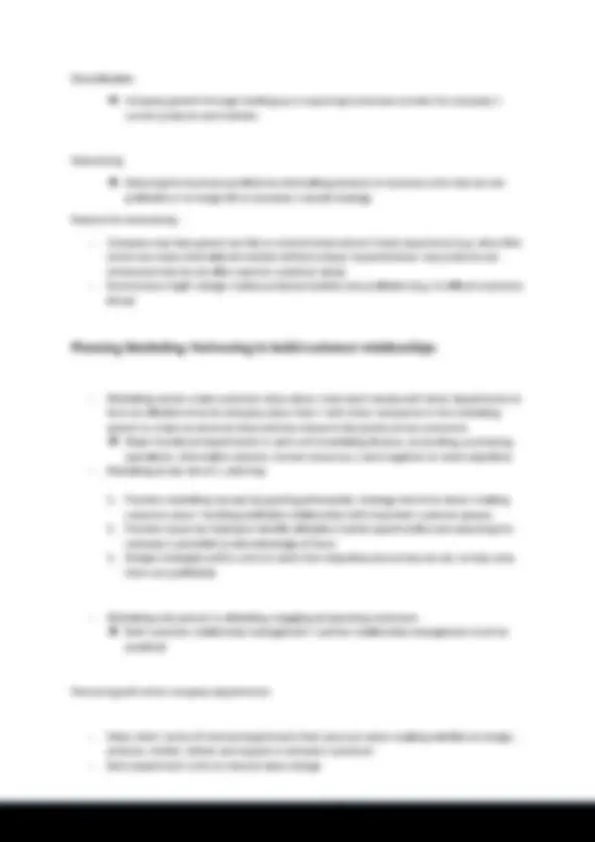
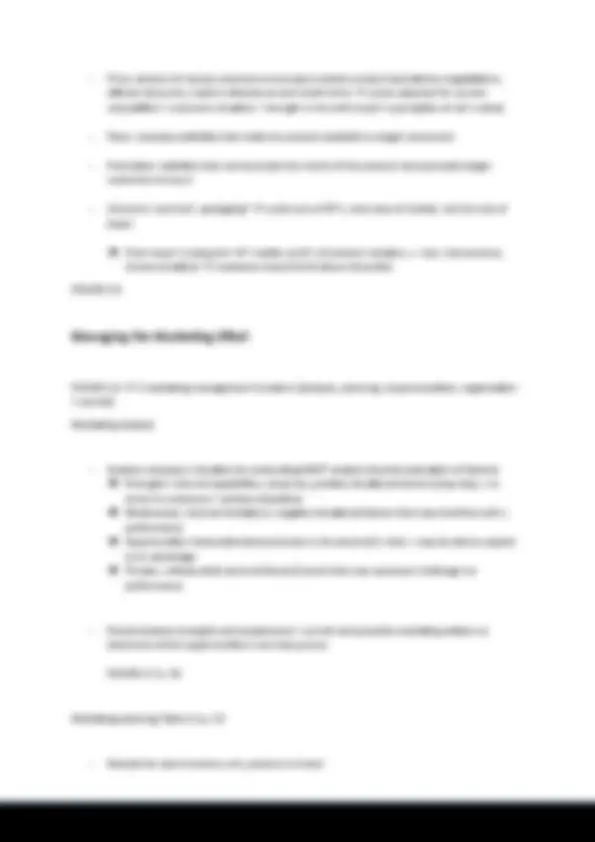
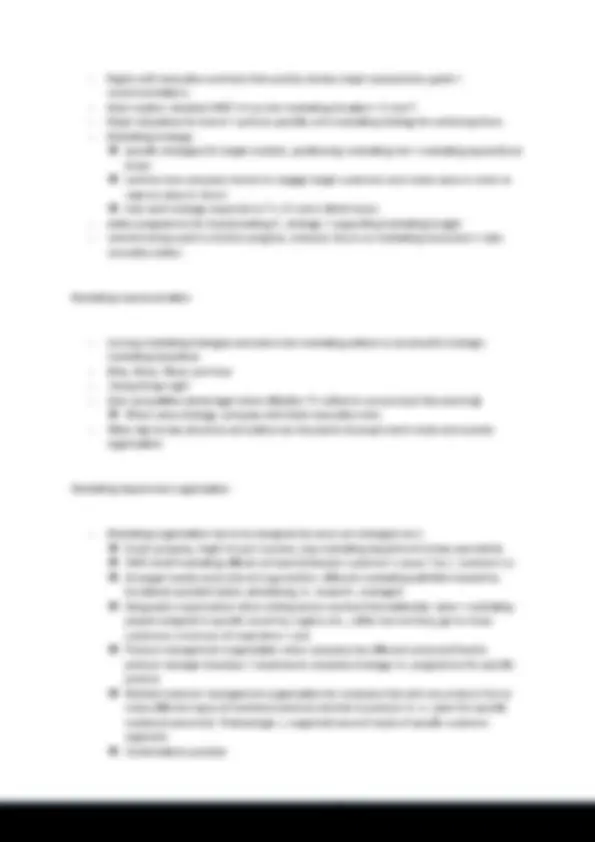
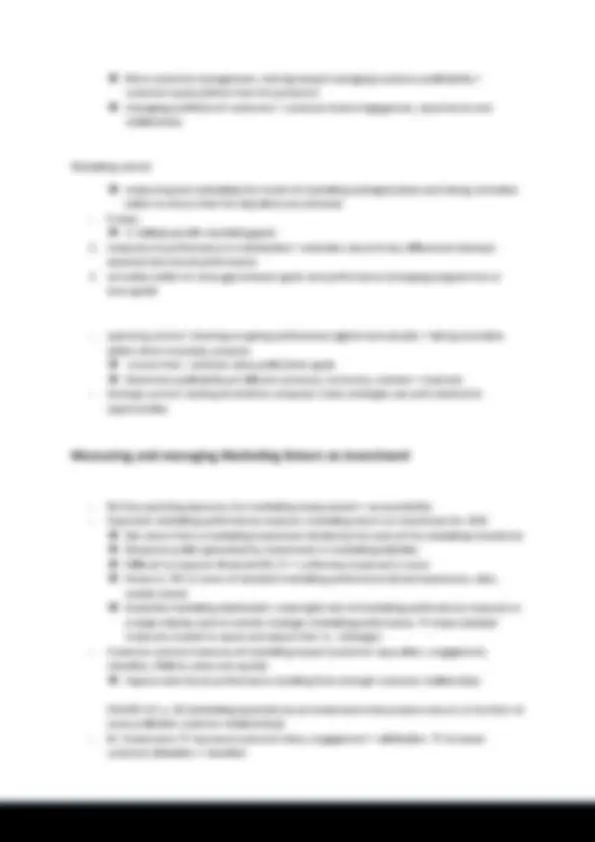
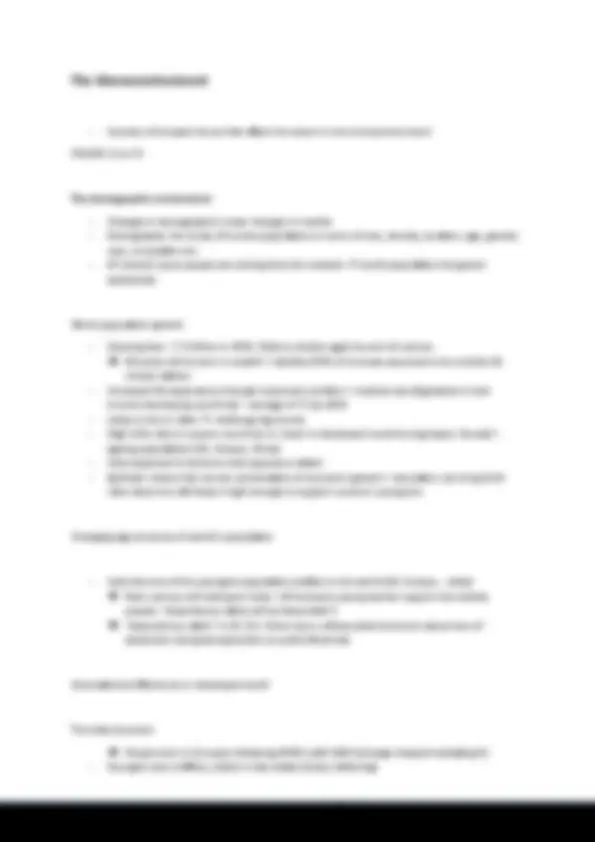
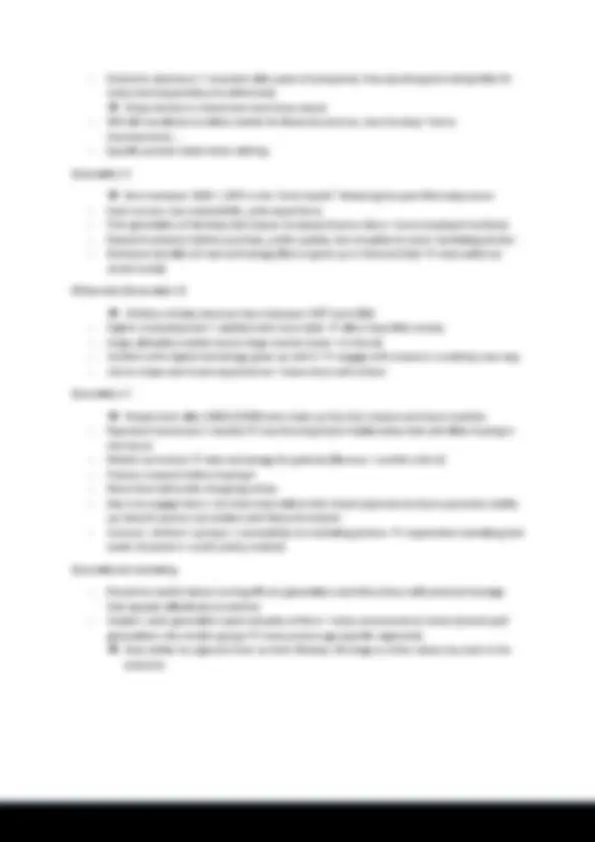
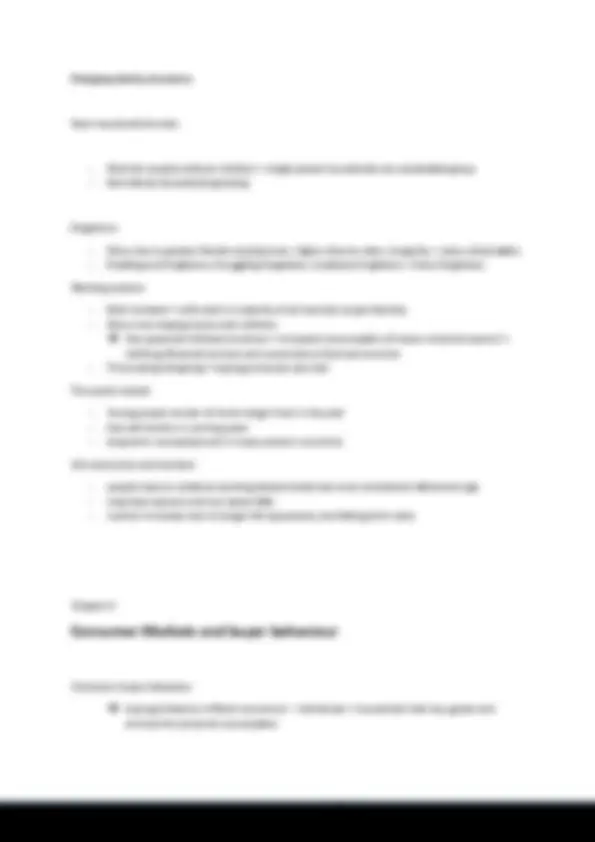
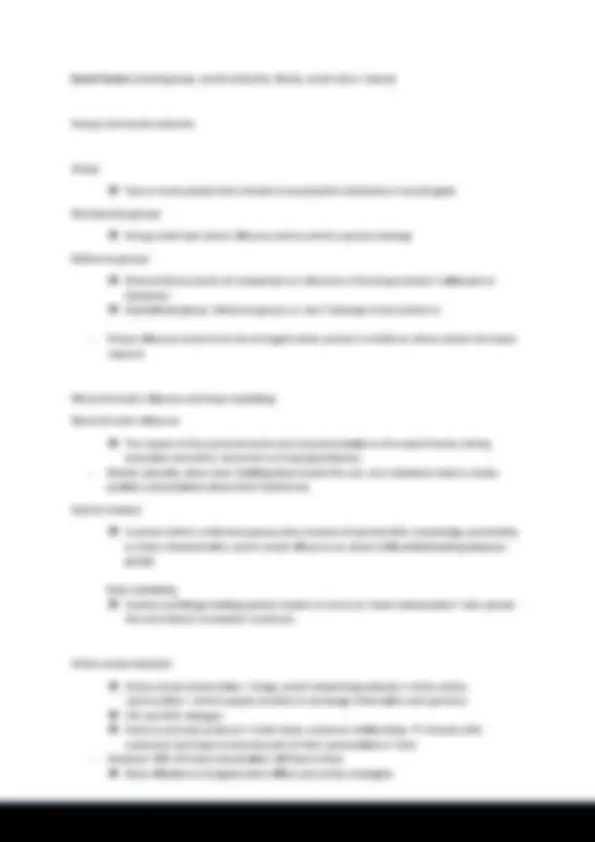
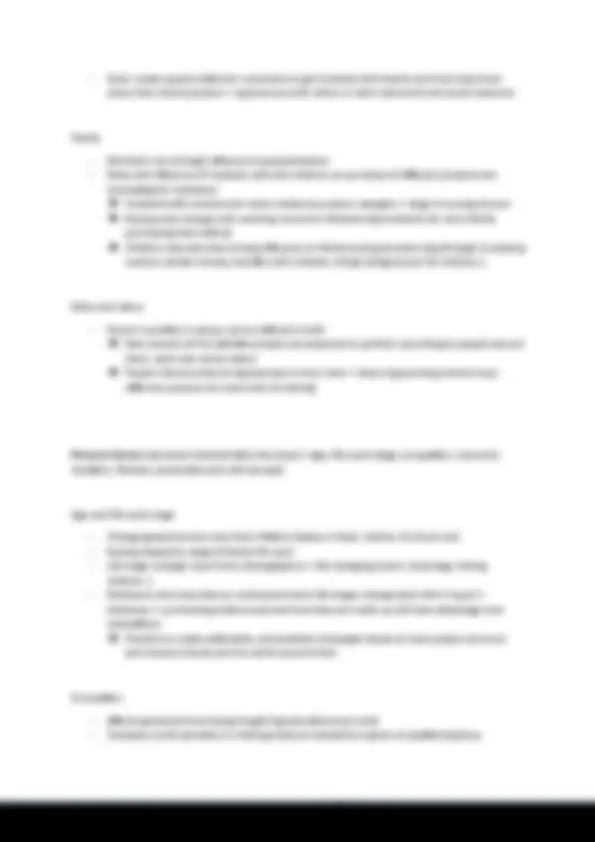
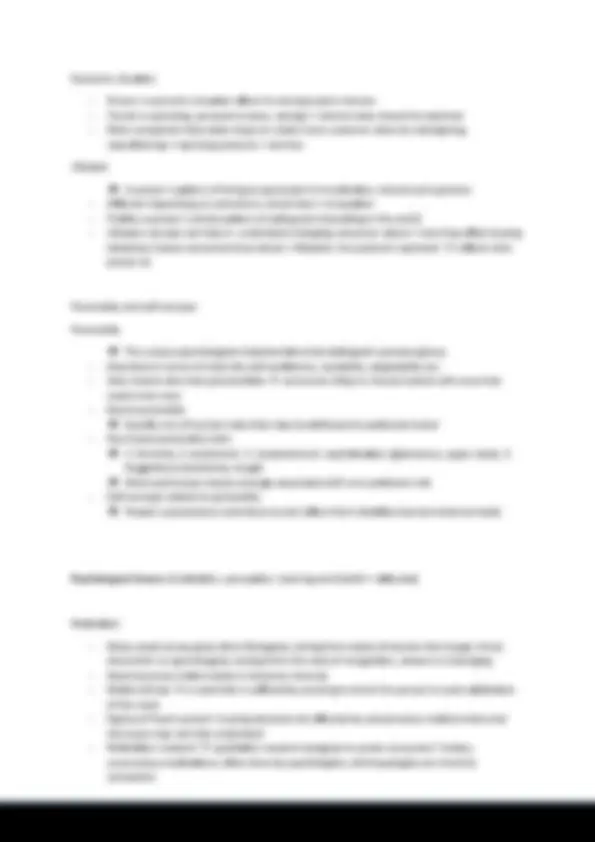
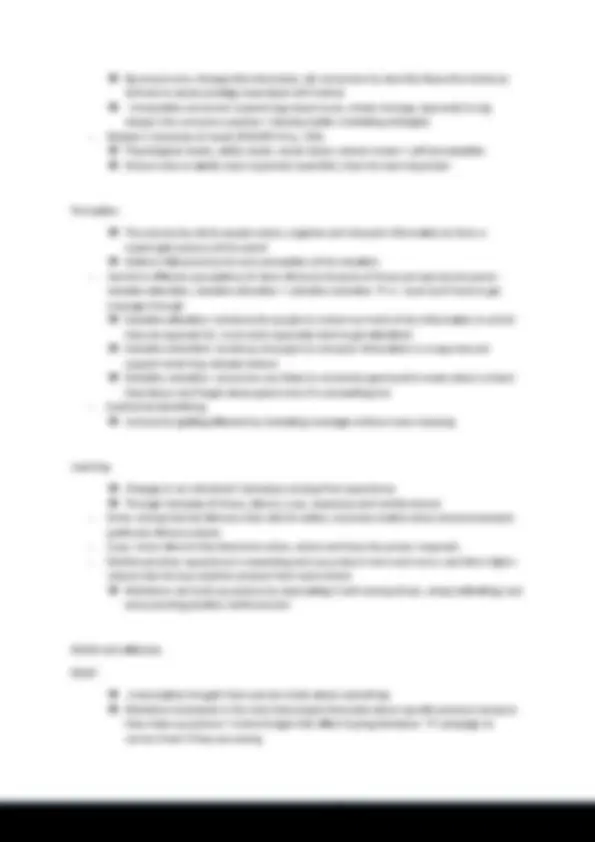
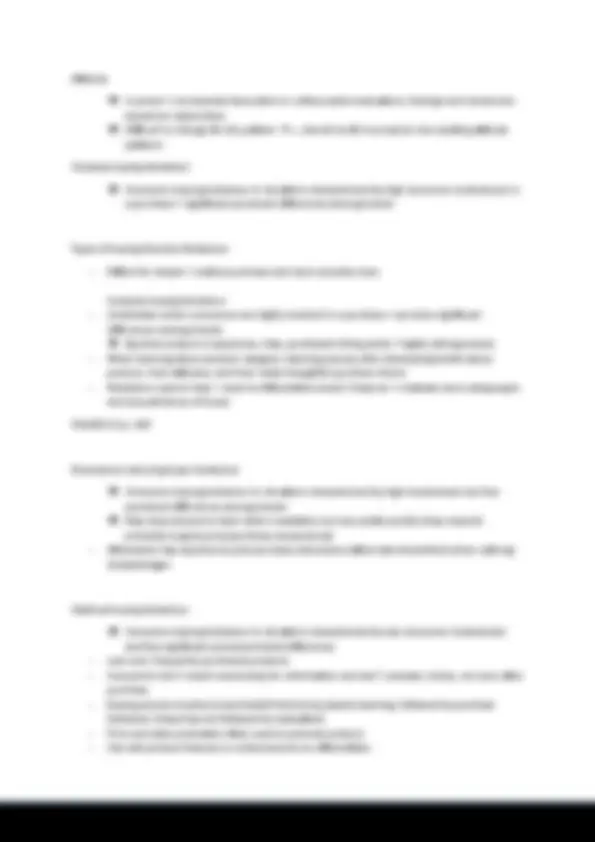
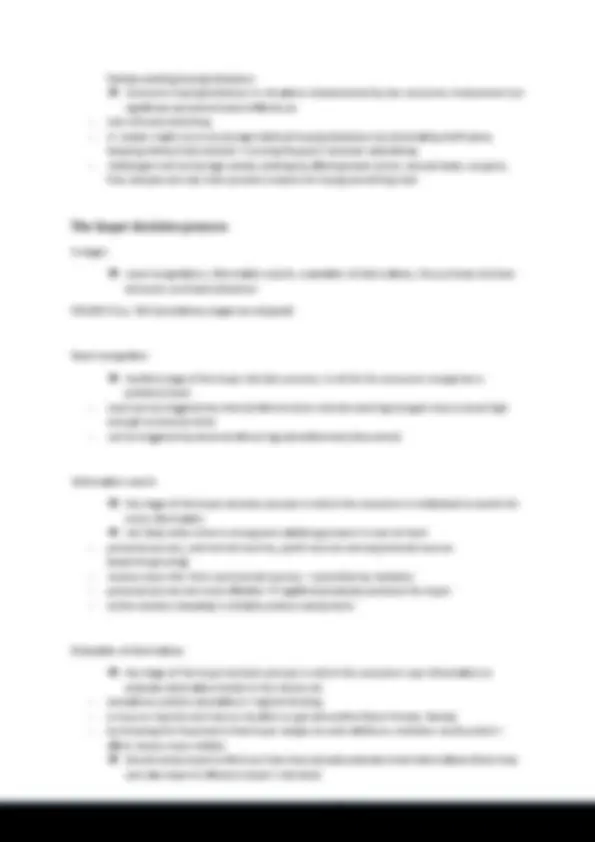
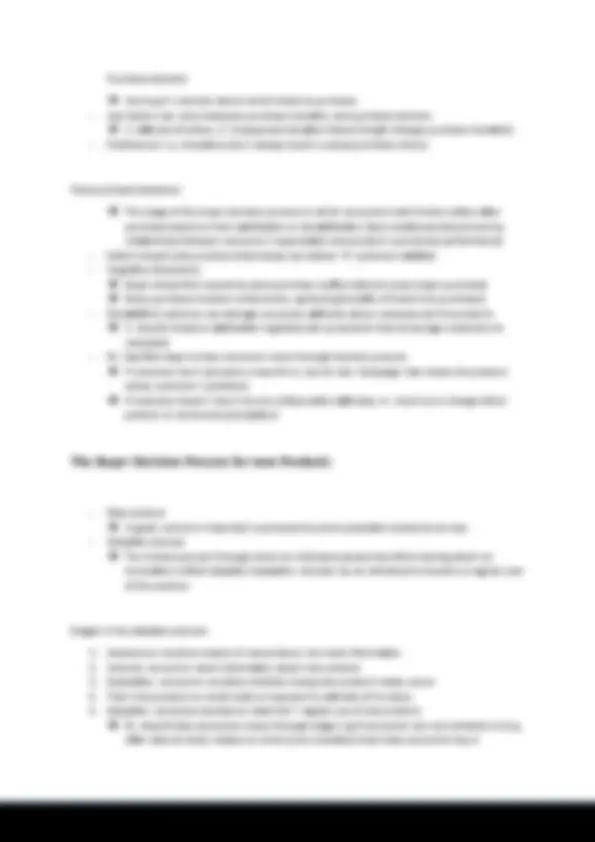
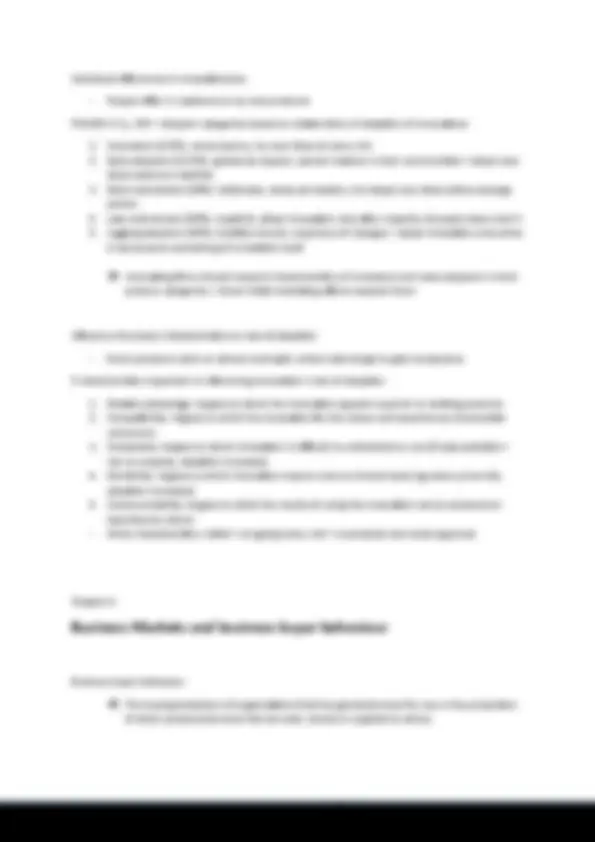
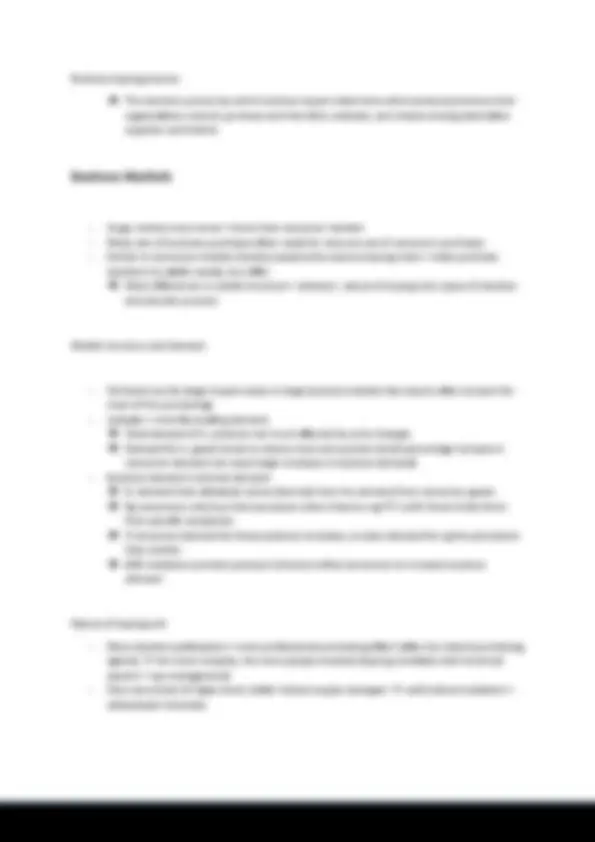
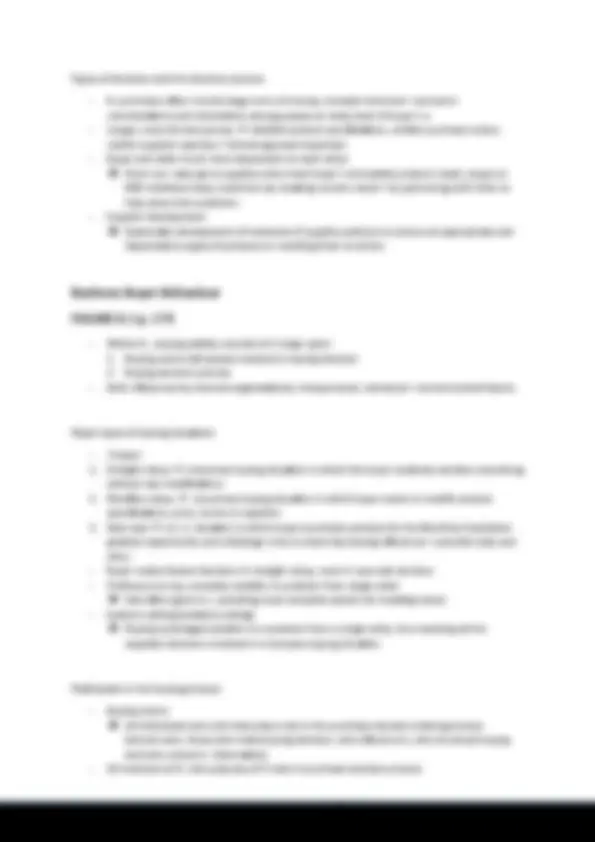
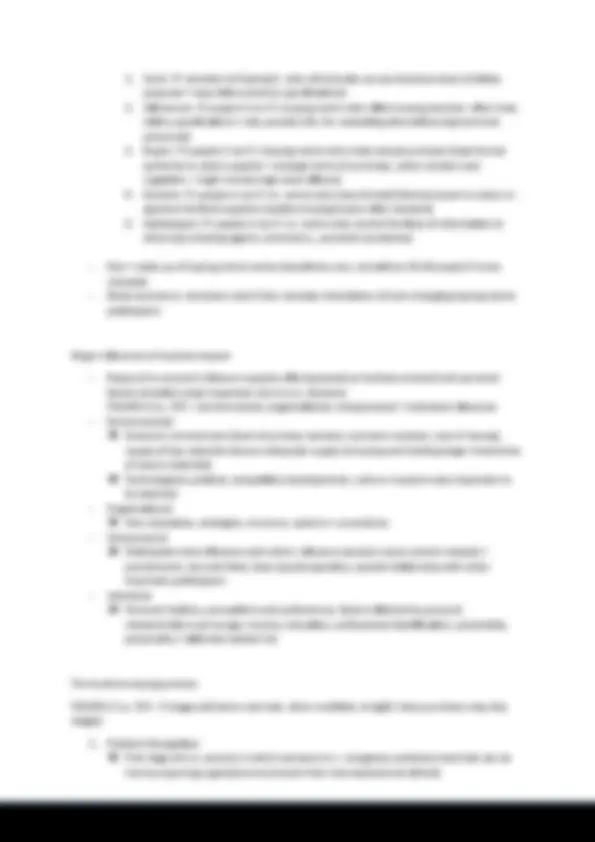
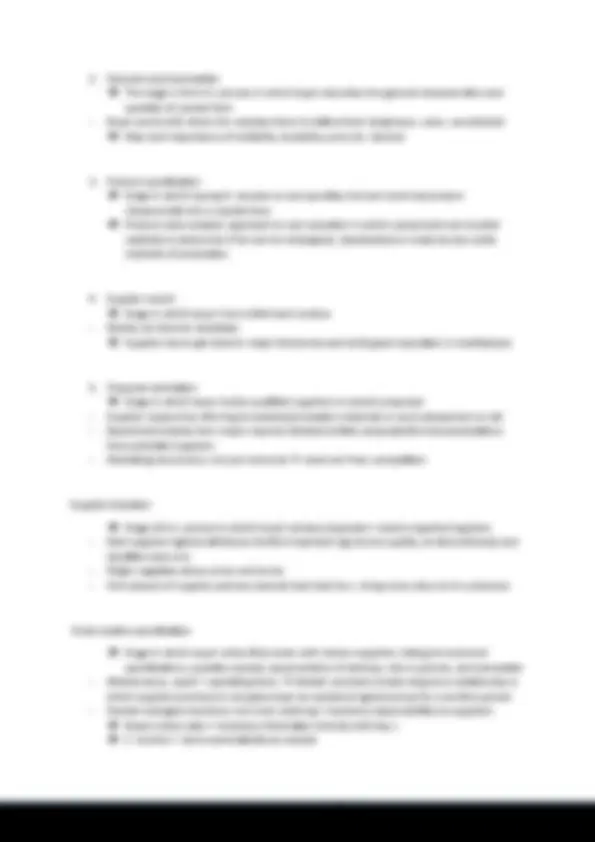
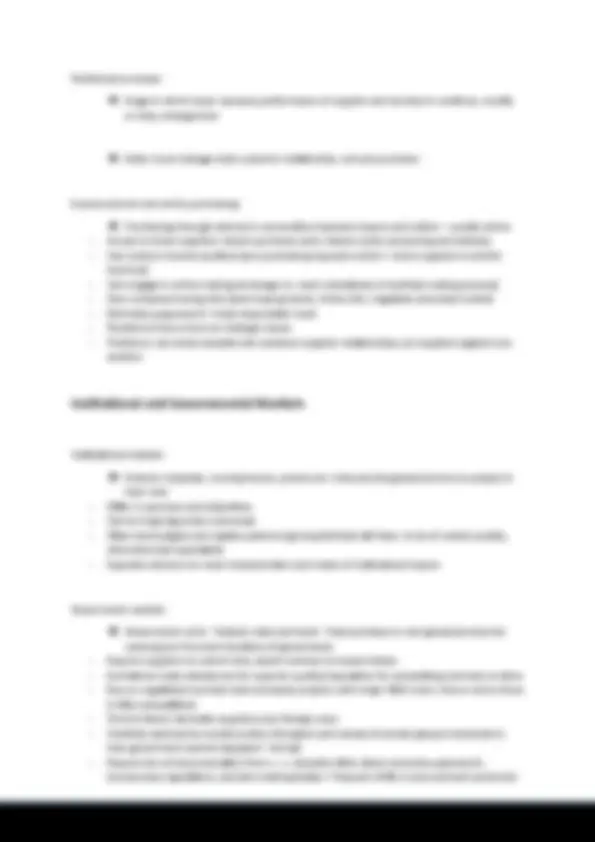



Study with the several resources on Docsity

Earn points by helping other students or get them with a premium plan


Prepare for your exams
Study with the several resources on Docsity

Earn points to download
Earn points by helping other students or get them with a premium plan
Community
Ask the community for help and clear up your study doubts
Discover the best universities in your country according to Docsity users
Free resources
Download our free guides on studying techniques, anxiety management strategies, and thesis advice from Docsity tutors
A summary of Chapter 2,3,5 and 6 of Priciples of Marketing, 7th edition.
Typology: Summaries
1 / 31

This page cannot be seen from the preview
Don't miss anything!
























Marketing Chapter 2
Company and marketing strategy
- Strategic planning: process of developing and maintaining a strategic fit between the os goals and capabilities and its changing marketing opportunities **-** Annual + long range plans: companys current business + how to keep it going - Strategic plan: adapting company + take advantages of opportunities (changing E.) - Corporate level: 1. definition of purpose + mission, 2. objectives, 3. What portfolio of business + products is best (and how much support to each), 4. Each business + product develops marketing/other plans supporting company-wide plan (at business-unit, product and market levels) support by more detailed plans for specific marketing opportunities
(FIGURE 2.1 – Steps)
- Mission statements that answer questions developed (What is our business?, Who is customer?, What do customers value?, What should our business be?) Statement of the os purpose – what it wants to accomplish in the larger environment (guiding asinvisible hand) Defined myopically (short-sighted) in product or technology terms (become outdated) so: should be market oriented and towards satisfying basic customer needs (last longer) BeQIK: focus on quality (Q), innovation (I), customer orientation) and speed Should be meaningful and specific yet motivating + emphasize companys strengths However often written for PR purposes + lack specific, workable guidelines (Jack Welch) Shouldn`t be stated as making more sales + profit, but focus on customers + customer experience the company seeks to create (profit only as reward for creating value) first accomplish market-focussed mission, profits will follow
- Company has to turn mission into detailed supporting objectives (for each level of management) manager should have them + is responsible - Broad mission leads to hierarchy of objectives (incl. business + marketing objectives) - Goals become companys current marketing objectives: such as improve profits by increasing sales/reducing costs or increase sales by improving companys share of of domestic + international markets
- M. objectives supported by developed marketing strategies + programmes (e.g. to increase a market share, the company might increase its product availability and promotion in existing markets and expand into new markets) - Broad marketing strategies must then be defined in better detail
TABLE 2.1 p. 40
- Guided by mission statement + objectives Business portfolio: the collection of business and product that make up the company (the best one fits the companys strengths and weaknesses to opportunities in environment) **-** Complex p.s of businesses and brands: strategic + marketing planning for these is daunting, but critical task: managing broad portfolios takes lots of management skill and imagination - Two steps in business portfolio planning: 1. Analysis of current business portfolio + determination which business should receive more, less, no investment 2. Must shape future portfolio by developing strategies for growth + downsizing
s core philosophy + competencies (when designing business p.) **-** Purpose of strategic planning: find ways in which company can best use its strengths to take advantage of attractive opportunities in E. Standard portfolio analysis methods evaluate SBUs on 2 dimensions: 1. Attractiveness of SBUs market/industry 2. Strengths of SBU`s position in that market/industryThe Boston Consulting Group Approach
- Growth-share matrix: market growth rate provides measure of market attractiveness (vertical axis), relative market share serves as a measure of company strength in market Defines 4 types of SBUs
Problems with matrix approaches
- Such centralised approaches have limitations, can be difficult, time-consuming + costly to implement - Difficult to define SBUs + measure market share and growth - Focus on classifying current businesses, only little advice for the future Many companies use more customized approaches that better suit specific situations Today`s strategic planning has been decentralised: now often cross-functional teams of divisional managers responsible (are close to markets)
Developing strategies for growth and downsizing
- Portfolio involves finding businesses + products to consider in the future Companies need growth to compete more effectively, satisfy stakeholders + attract top talent Also be careful not to make growth itself an objective, but to manage profitable growth(marketing has main responsibility of that) - Marketing needs to identify, evaluate and select market opportunities + establish strategies to capture them Identify growth opportunities with product/market expansion grid: a portfolio-planning tool for identifying growth opportunities through market penetration, m. development, product development or diversification
Market Penetration
Company growth by increasing sales of current products to current market segments without changing product
Market development
Company growth by identifying and developing new market segments for current company products
Product development
Company growth by offering modified or new products to current market segments
Diversification
Company growth through starting up or acquiring businesses outside the company`s current products and markets
Downsizing
Reducing the business portfolio by eliminating products or business units that are not profitable or no longer fit to company`s overall strategy
Reasons for downsizing:
- Company may have grown too fast or entered areas where it lacks experience (e.g. when firm enters too many international markets without proper research/when new products are introduced that do not offer superior customer value) - Environment might change: makes products/markets less profitable (e.g. in difficult economic times)
- Marketing cannot create customer value alone: most work closely with other departments to form an effective internal company value chain + with other companies in the marketing system to create an external value delivery network that jointly serves customers Major functional departments in each unit (marketing, finance, accounting, purchasing, operations, information systems, human resources..) work together to reach objectives - Marketing as key role of s. planning 1. Provides marketing concept (as guiding philosophy): strategy should be about creating customer value + building profitable relationships with important customer groups 2. Provides inputs by helping to identify attractive market opportunities and assessing the company`s potential to take advantage of them 3. Designs strategies within units to reach their objectives (once they are set, to help carry them out profitable) - Marketing only partner in attracting, engaging and growing customers Both customer relationship management + partner relationship management must be practiced
Partnering with other company departments
- Value chain: series of internal departments that carry out value-creating activities to design, produce, market, deliver and support a company`s products - Each department is link to internal value change
- Must understand their needs and wants to satisfy them careful customer analysis
Market segmentation
Dividing a market into distinct groups of buyers who have different needs, characteristics/behaviours, and who might require separate products or marketing programmes Grouped based on geographic, demographic, psychographic and behavioural factors Market segment consists of consumers who respond in a similar way to given set of marketing efforts (e.g. c. wants biggest, most comfy car regardless of price)
Market targeting
Process of evaluating each market segment`s attractiveness and selecting one or more segments to enter Company with limited resources: e.g. serve only one or a few special segments or market niches (that major competitors ignore) Most companies enter new market by serving single segment, then add more segments if successful
Market differentiation + positioning
- Positioning Arranging for a product to occupy a clear distinctive and desirable place relative to competing products in the minds of target consumers Identifying possible customer value differences that provide competitive advantages on which to build position (e.g. offer greater c. value by offering more benefits to justify higher prices) - Effective positioning begins with differentiation Actually differentiating the market offering to create superior customer value - Whole marketing programme should support chosen positioning strategies
Developing an integrated marketing mix
Marketing mix
The set of tactical marketing tools – product, price, place and promotion – that the firm blends to produce the response it wants in the larger market
- Product: goods-and-services combinations the company offers to target marhet
- Price: amount of money customers must pay to obtain product (sometimes negotiations, offered discounts, trade-in allowances and credit terms prices adjusted for current competitive + economic situation + brought in line with buyers perception of cars value) - Place: company activities that make the product available to target consumers - Promotion: activities that communicate the merits of the product and persuade target customers to buy it - Concerns: services?, packaging? under one of 4P`s, only view of market, not the one of buyer
From buyers viewpoint 4Ps better as 4C`s (Customer solution, c. cost, Convenience, Communication) marketers should think about these first
FIGURE 2.5.
FIGURE 2.6 5 marketing management functions (analysis, planning, implementation, organisation
Marketing analysis
- Analyse company`s situation by conducting SWOT analysis (overall evaluation of factors) Strengths: internal capabilities, resources, positive situational factors (may help c. to serve its customers + achieve objectives Weaknesses: internal limitations, negative situational factors that may interfere with c. performance Opportunities: favourable factors/trends in the external E. that c. may be able to exploit to its advantage Threats: unfavourable external factors/trends that may represent challenges to performance - Should analyse strengths and weaknesses + current and possible marketing actions to determine which opportunities it can best pursue
FIGURE 2.7 p. 52
Marketing planning Table 2.2 p. 53
- Needed for each business unit, product or brand
More customer management, moving toward managing customer profitability + customer equity (rather than the products`) managing portfolios of customers + customer-brand engagement, experiences and relationships
Marketing control
measuring and evaluating the results of marketing strategies/plans and taking corrective action to ensure that the objectives are achieved
- 4 steps 1. Setting specific marketing goals
- No free-spending anymore, but marketing measurement + accountability - Important marketing performance measure: marketing return on investment (m. ROI) Net return from a marketing investment divided by the costs of the marketing investment Measures profits generated by investments in marketing activities Difficult to measure: financial ROI, R + I uniformly measured in euros Assess m. ROI in terms of standard marketing performance (brand awareness, sales, market share) Assemble marketing dashboards: meaningful sets of marketing performance measures in a single display used to monitor strategic marketing performance shows detailed measures needed to assess and adjust their m. strategies - Customer-centred measures of marketing impact (customer acquisition, engagement, retention, lifetime value and equity) Capture also future performance resulting from stronger customer relationships
FIGURE 2.8. p. 56 (marketing expenditures as investments that produce returns in the form of more profitable customer relationships)
- M. investments improved customer value, engagement + satisfaction increases customer attraction + retention
Increases individual customer lifetime value + firm`s overall customer equity (determines return on marketing investment)
The company (internal environment)
- Other groups have to be taken into account (top management, finance, research + development (R&D) ...) - Top management sets company`s mission, objectives, broad strategies + policies Marketing managers make decisions within these
Suppliers
- Important link to c.`s overall customer value delivery network Provide resources needed by the company to produce its goods and services Supplier problems can affect m.: supply availability + costs must be watched Short run: supply shortages/delays, labour strikes etc. can cost sales, Long run: customer satisfaction damage Price increases through rising supply costs (can harm sales volume of c.) Suppliers treated as partners in creating + delivering customer value
Marketing intermediaries
Firms that help the company promote, sell and distribute its goods to final buyers
- E.g.: resellers, physical distribution firms, marketing services agencies + financial intermediaries - Resellers : distribution channel firms that help the company find customers/make sales to them (wholesalers/retailers who buy + resell merch.) Selecting + partnering with them not easy due to them becoming large, growing reseller organisations (eg Tesco) have enough power to dictate terms/even shut smaller manufacturers out of large markets - Physical distribution firms : help c. stock + move goods from points of origin to their destinations - Marketing services agencies : marketing research firms, advertising agencies, media firms + marketing consulting firms that help the c. target + promote products to right markets - Financial intermediaries : banks, credit companies, insurance companies etc. that help finance transactions/insure against the risks (associated with buying/selling of goods)
- Consists of broader forces that affect the actors in the microenvironment
FIGURE 3.2 p.
The demographic environment
- Changes in demographics mean changes in market - Demography: the study of human populations in terms of size, density, location, age, gender, race, occupation etc. - Of interest cause people are driving force for markets world population has grown explosively
World population growth
- Growing fast – 7.3 billion in 2015, likely to double again by end of century Minority will be born in wealth + stability (70% of increase expected to be outside 20 richest nations - Increased life expectancy through improved nutrition + medical care ()(greatest in low- income developing countries) – average of 71 by 2015 - Likely to live in cities challenge (eg slums) - High birth rates in poorer countries vs. lower in developed countries (eg Japan, Russia) + ageing populations (US, Europe, China) - India expected to become most populous nation - Eg Brazil: shows that correct combination of economic growth + education can bring birth rates down but still keep it high enough to support country`s prospects
Changing-age structure of world`s population
- India has one of the youngest population profiles in the world (US, Europe….older) Next century will belong to India + Africa (more young worker support less elderly people: “dependency ratios will be favourable”) “dependency ratios” in US, EU, China more unfavourable (concerns about loss of dynamism and growing burden on public finances)
Generational differences in developed world
The baby boomers
People born in the years following WW2 until 1964 (strongly shaped marketing E.)
- Youngest now in fifties, oldest in late sixties (many retirering)
- Economic downturn + recession after years of prosperity, free-spending and saving little hit many hard (especially pre-retirement) Sharp decline in investment and home values - Will still constitute lucrative market for financial services, new housing + home improvements… - Specific pension deals when retiring
Generation X
Born between 1965 + 1975 in the birth dearth following the post-War baby boom
- Seek success, less materialistic, prize experience - First generation of latchkey kids (cause increased divorce rates + more employed mothers) - Research products before purchase, prefer quality, less receptive to overt marketing pitches - Embraces benefits of new technology (first to grow up in Internet Era)n most active on social media)
Millennials (Generation Y)
Children of baby boomers born between 1977 and 2000
- Higher unemployment + saddled with more debt often have little money - Huge, attractive market due to large number (now + in future) - Comfort with digital technology, grew up with it engage with brands in a entirely new way - Like to shape own brand experiences + share them with others
Generation Z
People born after 2000 (/1995) who make up the kids, tweens and teens markets
- Represent tomorrows markets now forming brand relationships that will affect buying in the future **-** Mobile connected take technology for granted (fluency + comfort with it) **-** Product research before buying it **-** More than half prefer shopping online **-** Key is to engage them + let them help define their brand experiences (more personal, tactile, up close/in-person connection with favourite brands **-** Concern: childrens privacy + vulnerability to marketing pitches responsible marketing (risk wrath of parents + public policy makers)
Generational marketing
- Should be careful about turning off one generation each time they craft product/message that appeals effectively to another - Caution: each generation spans decades of time + many socioeconomic levels (should split generations into smaller groups more precise age-specific segments) Even better to segment them ny their lifestyle, life stage or other values tey seek in the products
Consumer market
all individuals + households that buy or acquire goods and services for personal consumption
Model of Consumer Behaviour
FIGURE 5.1 p. 139
CQ: How do consumers respond to various marketing efforts the company might use?
- Marketing + other stimuli enter black box of consumer + produce certain responses Marketers must figure out whats in the black box **-** Marketing stimuli: 4Ps, others: major forces + events in buyers environment (STEP) **-** Input turned in responses buyers attitudes + preferences, brand engagements + relationships and what he buys, when, where and how much - Understand how stimuli are changed into responses inside the consumers black box Black box: 1. Buyers characteristics influence how he perceives + reacts to stimuli 2. Buyer`s decision process itself affects behaviour
Characteristics affecting Consumer behaviour
FIGURE 5.2 p. 140 – consumer purchases influenced by cultural, social, personal + psychological characteristics (cannot be controlled but must be taken into account)
Cultural factors
Culture
Set of basic values, perceptions, wants and behaviours learned by a member of society from family and other important institutions
- Most basic cause of wants and behaviour (which is largely learned) - Learns/is exposed to values: achievement + success, freedom, individualism, hard work, activity + involvement, efficiency, health… - Every group + society has culture varies from county to county and country to country
Subculture
A group of people with shared value systems based on common life experiences + situations Include nationalities, religions, racial groups + geographic regions (eg cybergoths and bodybuilders, might be not mutually exclusive)
- Two contrasting examples: gamers + mature consumers
Gamers
- Anybody who enjoys playing or learning about video games – off and online (25% of Europe`s population)
Mature consumers
- Attractive market for companies in all industries - Older consumers are more willing to shop around + switch brands (foreg computers, mobile phones) than younger people - Often don`t act old or see themselves like that must adjust marketing - More likely to take longer, more expensive holidays attractive market for t.a.
Social Class
Relatively permanent + ordered divisions in a society whose members share similar values, interests + behaviours
FIGURE 5.3 p. 143 – major social classes
- Form of social class structure in every one - Measured as a combination of occupation, income, education, wealth etc. - In some social systems classes are reared for certain roles and cannot change social positions - In Europe: lines not fixed - People within same class tend to have similar buying behaviour (show distinct product + brand preference in eg clothing and home furnishings)
BBC study suggests 7, radically different distinct classes
Key difference: dependence on social and cultural capital as pivotal reflectors of class + prospects (+ traditional measure of income)
- Goal: create opportunities for customers to get involved with brands and then help them share their brand passions + experiences with others in both real world and social networks
Family
- Members can strongly influence buying behaviour - Roles and influence of husband, wife and children on purchase of different products are interesting for marketers Husband-wife involvement varies widely by product category + stage in buying process Buying roles change with evolving consumer lifestyles (eg husbands do more family purchasing than before) Children may also have strong influence on family buying decisions (eg through increasing number, pocket money, benefits with children, things designed just for children..)
Roles and status
- Person`s position in group can be defined in both Role consists of the activities people are expected to perform according to people around them, each role carries status People choose products appropriate to their roles + status (eg working mother buys different products for work than for family)
Personal factors (personal characteristics like buyer`s age, life-cycle stage, occupation, economic situation, lifestyle, personality and self-concept)
Age and life-cycle stage
- Change goods/services over their lifetime (tastes in food, clothes, furniture etc) - Buying shaped by stage of family life cycle - Life stage changes result from demographics + life-changing events (marriage, having children..) - Marketers who have data to understand when life-stages change (and with it buyer`s behaviour + purchasing preferences) and how they are made up will have advantage over competitors Possible to create actionable, personalised campaigns based on how people consume and interact brands and the world around them
Occupation
- Affects goods/services being bought (eg executive buys suits) - Company could specialise in making products needed by a given occupational group
Economic situation
- Person`s economic situation affect his store/product choices - Trends in spending, personal income, savings + interest rates should be watched - Most companies have taken steps to create more customer value by redesigning, repositioning + repricing products + services
Lifestyle
A person`s pattern of living as expressed in his activities, interest and opinions
- Different depending on subculture, social class + occupation - Profiles a person`s whole pattern of acting and interacting in the world - Lifestyle concept can help m. understand changing consumer values + how they affect buying behaviour (cause consumers buy values + lifestyles the products represent reflects who person is)
Personality and self-concept
Personality
The unique psychological characteristics that distinguish a person/group
- Described in terms of traits like self-confidence, sociability, adaptability etc. - Idea: brands also have personalities consumers likely to choose brands with ones that match their own - Brand personality Specific mix of human traits that may be attributed to particular brand - Five brand personality traits 1. Sincerity, 2. excitement, 3. Competence,4. sophistication (glamorous, upper class), 5. Ruggedness (outdoorsy, tough) Most well-known brands strongly associated with one particular trait - Self-concept related to personality People`s possessions contribute to and reflect their identities (we are what we have)
Psychological factors (motivation, perception, learning and beliefs + attitudes)
Motivation
- Many needs at any given time: Biological, arising from states of tension like hunger, thirst, discomfort or psychological, arising from the need of recognition, esteem or belonging - Need becomes motive (when it becomes intense) - Motive (drive) a need that is sufficiently pressing to direct the person to seek satisfaction of the need - Sigmund Freud: persons buying decisions are affected by subconscious motives that even the buyer may not fully understand **-** Motivation research qualitative research designed to probe consumers hidden, unconscious motivations, often done by psychologists, anthropologists etc hired by companies